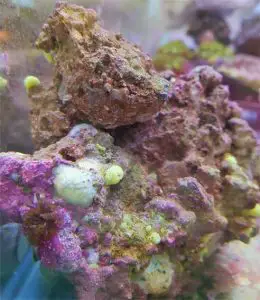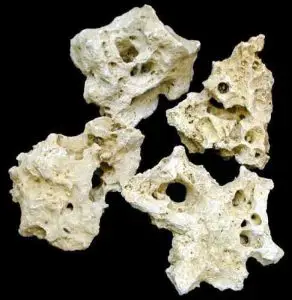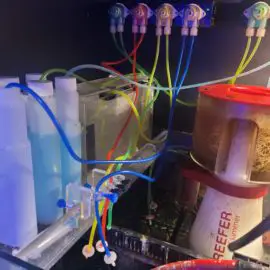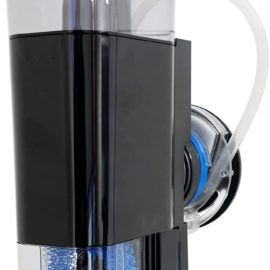Live Rock
What is live rock?
Live rock for saltwater aquariums, more than anything else, is a saltwater aquarium filter.
Live rock was dry ocean rock, also known as aquarium base rock. The correct term for this type of rock is aragonite.
Aragonite is a type of rock that consists mainly of calcium carbonate which in some cases is long dead coral skeleton depending on collection points and the vicinity to the ocean. The reason aragonite is so effective in a saltwater aquarium is because it is extremely porous, with numerous micro tunnels, holes, nooks and crannies. Think of it as a hardened sponge.
So, is this really alive? The porousness of aragonite creates a perfect large surface area allowing water to pass through and around it. This encourages the growth of microorganisms. The microorganisms are the ‘live’ part of the rock, thus giving it it’s name.
Microorganisms play a crucial role is breaking down nutrients in your system, converting ammonia to nitrite, nitrite to nitrate, and then nitrate to nitrogen. This is also known as the nitrogen cycle.
Unlike tropical freshwater tanks which rely primarily on a filter to mechanically force water through filter media to clean and maintain good levels of nitrifying bacteria, most saltwater tanks use live rock as their primary filter.
External filters are used by some aquarists for saltwater tanks, but these are generally used in the absence of an aquarium sump to house nitrate and phosphate removal media, as well as filter wool to polish the water (although this needs replacing every two to four days to prevent nitrate buildup).
At one stage ocean this type of rock was readily available. In fact, top grade Fiji Live Rock consisted of bits of dry ocean rock that were stuck together and then hung by fishing line in the Fijian Sea for a period of two years. This allowed the ocean inhabitants to colonise the dry rock, including coralline algae and microorganisms.
Once the rock had been ‘cured’ over the two years, it was cut away and wrapped up to maintain its moisture, then flown around the world. On arrival in it’s destination country it would immediately be transferred into holding tanks to allow the organisms to recuperate. On purchasing this particular type of rock, you could see the fishing line used in the curing process.
On 4 August 2008 CITES (the Convention on International Trade in Endangered Species of Wild Fauna and Flora) banned the collection of live rock from Tonga, Marshall Islands and the Cook Islands. In addition, in December 2017 Fiji immediately banned the export of it for a period of 70 days.
So far the cured live rock referred to has originated from abroad, exported for the marine aquarium trade. However not all of it is shipped from abroad.
Dry ocean rock placed in an existing saltwater tank will become live over a six week period as the microorganisms already living in the tank inhabit it. In fact many larger marine retailers have dedicated ‘curing tanks’ which are used to supply live rock to the public.
Unfortunately purchasing rock cured in this way is more likely to become problematic, unless your LFS is known to produce good quality live rock. All too often these tanks, and therefore the rock, become not only a habitat for beneficial organisms but unwanted ‘hitchhikers’ too. Aiptasia anemone and Vermatid snails are far too common in these holding tanks. Invasive macroalgae also tend to be found hiding in nooks and crannies.
Always check live rock very carefully before purchasing to avoid problems later on.
What is 'cured' live rock?
As discussed above, ‘cured’ live rock is purchased while it is still in water. It will have been in the water for at least 6 weeks to encourage the growth of microorganisms. This ‘cured’ rock is immediately ready to use in your aquarium.
A common question is, ‘How long does it take live rock to cycle?’ Assuming the rock is live rock that needs to be cured, the above mentioned 6 weeks would ensure your rock is cycled.
When live rock is removed from the ocean or a ‘curing’ tank at your LFS, you are removing it from water. By doing so, the micro and macroscopic marine life living on and in the rock will begin to die immediately due to lack of water.
By placing the rock in your tank water again, you are encouraging the organisms and bacteria to re-establish themselves and recolonise. In other words, the rock is ‘curing’. You know when it is cured, when the die off that occurred while out of the water is no longer creating elevated levels of ammonia and nitrites.
What is 'uncured' live rock?
‘Uncured’ rock is live rock which has been removed from the ocean, kept damp during transit, and only the hardiest of organisms will have survived on it while it is being shipped around the world. The drier the rock becomes, the more the die off, and therefore is ‘uncured’. Once it gets to its destination it will be added to a curing tank which gives the organisms and bacteria a chance to re-establish themselves.
Similar to above, uncured live rock could also be live rock removed from a tank, and transported over a considerable distance, in which time the rock will have die off and become uncured.
Uncured rock should never be added to an existing setup, as the bacteria in your system will not be able to handle the sudden influx of die off. This will elevate ammonia levels causing another cycle, and potentially a system crash where everything dies.
How long can live rock be out of water?
Live rock abounds with life suited to the environment created in your tank. The moment you remove it from your aquarium the microorganisms that have made it their home, begin to die. This is known as ‘die-off’.
When purchasing live rock and transporting it to your newly set up aquarium, it will almost be impossible to transport in water. The longer the trip out of water between the shop and your home is, the more severe the die-off will be.
A general rule of thumb is to get the rock into water as soon as you possibly can. The longer it remains out of water, or allowed to dry, the more likely it will no longer be ‘live’.
If you have to transport live rock for an extended period, the priority is to keep the rock damp. This could be achieved with newspaper and a periodic spray of aquarium water to keep the newspaper and rock from drying out.
Ultimately, the longer the rock is out of water, the more severe the die-off will be, and the longer you will need to cure it.
Dead rock
‘Dead’ rock was live rock that has been removed from water for an extended period. The rock has completely dried out causing the death of all organisms living on the rock.
If you are placing this rock in a new setup, you should be prepared for elevated levels of ammonia, nitrates, and phosphates for an extended period of time (given off by the bodies of dead organisms) during a tank cycle and many months afterwards. They will not include living beneficial organisms and bacteria.
Should you see someone selling “live” rock with a photo showing it outside of water, then it WAS live rock. It is now dead.
What is dry rock (base rock)?
Dry rock is long dried out aragonite rock removed from beaches and sea shores (as discussed above). These rocks are collected and sold dry. They do not ordinarily have much organic material on them, but if they do it is remedied by ‘curing’.
When using dry ocean rock bacteria needs to be established to get the nitrogen cycle rolling. See this article on how to cycle your saltwater tank and the methods of bacteria introduction.
Available base rock brands:
Marco Rock sells Key Largo Dry Rock (available through your LFS) and these have become a sort after aquarium rock for many marine tanks, guaranteed as 100% free of organic material.
Pukani Dry Rock is another favourite, but unlike Key Largo Rock, Pukani has the appearance of large coral trees. It really does depend on your preference.
Caribsea Life Rock is dry rock which has been painted to mimic the colour of coralline algae with ‘live spored bacteria’ added. The idea is that the spored bacteria will proliferate when added to your tank.
There is also unbranded dry rock available in most LFS. Dry rock does not impact directly on the marine environment due to the manner in which they collected.
Live rock alternatives
There are also man-made rocks and structures available made of porous ceramics or aragonite mixtures, which are just as capable of becoming live.
Real Reef Rock is a man-made rock coloured to mimic coralline algae growth. These look, feel and work just as you would expect live rock to work.
Arka Rock is a Maidenhead Aquatics product (UK). It features tower structures, bridges and plateaus made in Germany. These were a ceramic product, but there have been unconfirmed reports that it has become very difficult to get the ceramic version now.
Aquaroche is a ceramic alternative, similar to Arka Rock but with differing designs. Aquaroche is the premium alternative which is more of an artwork than a rock scape in your tank.
A warning: Dry rock and dinoflagellates
In recent years, the increased use of dry rock and man-made alternatives has lead to an increase in the incidence of a highly invasive ‘algae’ which is extremely difficult to rid your system of. Dinoflagellates have become more and more common.
The unsubstantiated theory is that live rock already harbours life within and without the rock structure and this life makes it very difficult for dinoflagellates to take a foothold. However, when starting a saltwater tank with dry rock you are using a rock which is devoid of life. This absence of life allows dinoflagellates to flourish without being challenged.
Having been in reef keeping myself for many years I had always used live rock to start a saltwater tank, even my very first nano aquarium. I had never had an occurrence of dinoflagellates (dino). However, in my most recent upgrade I decided to use dry rock and have been battling dinoflagellates ever since.
My advice would be to use live rock. If you have unfortunately ended up with dreaded dino, then take a look at this article which explains the steps I’ve taken to get rid of it and how I eventually managed to beat it.
Conclusion
Hopefully this article has given you a good overview. Live rock plays a pivotal role in the biological filtration of saltwater aquariums. It not only provides a home for the good bacteria and microorganisms your system depends on and hiding places for fish and invertebrates, it also provides a surface on which coral can grow.








